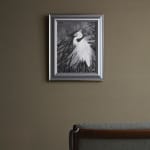Kayama Matazō (1927−2004)
White Egret
Color and gold on paper, framed (15P)
With a box signed by the artist
Seal: Matazo
66.5 x 51 cm
87 x 72 cm (overall)
Further images
In Kayama Matazo’s works, location or situation is perhaps not a central factor. The present work might be depicting an egret among a grass field along a river, glittering against a dark background. Kayama might apply silver leaves, silver paint, and platinum to create the texture of crumpled paper. This decorative factor contributes to the depiction of an imagined monochromatic world, which is a distinguished feature of Kayama’s art.
Kayama had been interested in depicting animals since his youth, and sketched a variety of animals, including monkey, fox, deer, and eagle, during his days at the Kyoto City School of Arts and Crafts. After the war, at his twenties, Kayama chose the subject of animal to create nihonga of his own style: “I wish to produce novel nihonga that reflects how I myself live and feel at the particular moment, through the expressions of the sorrow of herbivores, the solitariness of carnivores, their toughness and vitality, as well as the cold or warm atmosphere around them and their appearances.” The present work, although dated slightly later, clearly reflects what Kayama states in the above words.
Kayama Matazo (nihonga painter; 1927–2004)
Kyoto-born nihonga painter. Graduated from the Kyoto City School of Arts and Crafts and Tokyo School of Fine Arts. A student of Yamamoto Kyujin. Received awards such as the Nihon geijutsu taisho (Grand Prize for Japanese Fine Arts), the Ministry of Education Award of the Art Encouragement Prizes, and the Japan Association for the Promotion of Arts Award. Appointed Tama Art University and Tokyo University of the Arts professor. Member of Soga-kai. Designated as a Person of Cultural Merit and received the Order of Culture.
Kayama had been interested in depicting animals since his youth, and sketched a variety of animals, including monkey, fox, deer, and eagle, during his days at the Kyoto City School of Arts and Crafts. After the war, at his twenties, Kayama chose the subject of animal to create nihonga of his own style: “I wish to produce novel nihonga that reflects how I myself live and feel at the particular moment, through the expressions of the sorrow of herbivores, the solitariness of carnivores, their toughness and vitality, as well as the cold or warm atmosphere around them and their appearances.” The present work, although dated slightly later, clearly reflects what Kayama states in the above words.
Kayama Matazo (nihonga painter; 1927–2004)
Kyoto-born nihonga painter. Graduated from the Kyoto City School of Arts and Crafts and Tokyo School of Fine Arts. A student of Yamamoto Kyujin. Received awards such as the Nihon geijutsu taisho (Grand Prize for Japanese Fine Arts), the Ministry of Education Award of the Art Encouragement Prizes, and the Japan Association for the Promotion of Arts Award. Appointed Tama Art University and Tokyo University of the Arts professor. Member of Soga-kai. Designated as a Person of Cultural Merit and received the Order of Culture.







